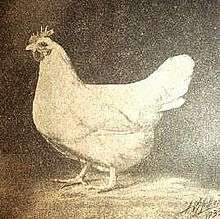Lamona
The Lamona is a breed of chicken originating in the United States. It was developed in the early 20th century by Harry S. Lamon, who was the senior poultry expert at the Bureau of Animal Industry,[2] an agency that was eventually replaced by the U.S. Department of Agriculture's Agricultural Research Service.[3]
 Illustration of a Lamona pullet from 1933 | |
| Country of origin | United States |
|---|---|
| Traits | |
| Skin color | yellow |
| Egg color | white |
| Comb type | single |
| Classification | |
| APA | American[1] |
| ABA | single comb clean legged |
| |
History
Working at the Henry A. Wallace Beltsville Agricultural Research Center in Beltsville, Maryland, Lamon crossed White Plymouth Rocks, Silver-Gray Dorkings and White Leghorns to produce the Lamona. The effort began in 1912 and by 1933 it was recognized as a breed by admittance into the American Poultry Association's Standard of Perfection.[4] A bantam version was miniaturized from the standard Lamona, and it was recognized by the APA in 1960.
Due to their strong production characteristics, Lamonas endured a brief popularity in the first half of the 20th century. But after the 1950s, commercial chicken farms switched to the two breeds that dominate the industry into the 21st century: the Cornish-Rock hybrid for meat and the White Leghorn for eggs.
By the 1980s, Lamonas were close to extinction.[4] The work of a few dedicated preservationists, such as Marion Nash of Illinois, perpetuated the breed for a time. But today, the original Lamona is very rare. There are reports from American Livestock Breeds Conservancy and anecdotal sources, the most recent circa 2005, of one or two breeding flocks still in existence, but none of these breeders offer Lamonas for sale.[5]
One line of Lamonas was created in the early 2000s by Steve Gerdes of Illinois. He recreated this line using the same methods that were used by Harry Lamon to create the originals. After his death in 2012 these birds went to two separate breeders who are still working on them.
Since the disappearance of the original large Lamona, Jeremy Trost used the breeds known to have first been used in its creation to reconstitute a new bantam Lamona which was finalized in the first five years of the 21st century.[6]
Characteristics
Lamonas weigh more than the light Leghorn, but less than the large Plymouth Rock and Dorking. They have yellow skin and white plumage, which makes them ideal meat birds for the U.S. market. They have single combs and red earlobes, and while chickens with red earlobes usually lay brown eggs, Lamonas lay large white eggs.[4] Also unlike most chickens, Lamonas were once said to retain quality as a meat bird after they had passed their egg laying prime (2-3 years).[2]
Footnotes
- APA Recognized Breeds and Varieties: As of January 1, 2012. American Poultry Association. Archived 4 November 2017.
- (Ekarius 2007, p. 28)
- "Records of the Bureau of Animal Industry". archives.gov. National Archives and Records Administration. Retrieved 2008-06-21.
- (Heinrichs 2007, p. 54)
- (albc-usa.org)
- (feathersite.com)
References
- Ekarius, Carol (2007). Storey's Illustrated Guide to Poultry Breeds. Storey Publishing. ISBN 978-1-58017-667-5.
- Heinrichs, Christine (2007). How To Raise Chickens. Voyageur Press. ISBN 978-0-7938-0601-0.
- "albc-usa.org". Lamona Chicken. American Livestock Breeds Conservancy. Retrieved 2008-06-21.
- "Lamona". feathersite.com. Retrieved 2008-06-21.
- "Lamona". albc-usa.org.